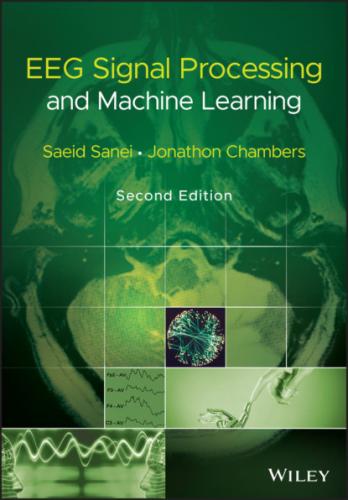(4.129)
PCA is widely used in data decomposition, classification, filtering, and whitening. In filtering applications, the signal and noise subspaces are separated and the data are reconstructed from only the eigenvalues and eigenvectors of the actual signals. PCA is also used for BSS of correlated mixtures if the original sources can be considered statistically uncorrelated.
Figure 4.13 Adaptive estimation of the weight vector w(n).
The PCA problem is then summarized as how to find the weights w in order to minimize the error given the observations only. The LMS algorithm is used here to iteratively minimize the MSE as:
(4.130)
The update rule for the weights is then:
(4.131)
where the error signal e(n) = x(n) − ΦT (n)w(n), x(n) is the noisy input and n is the iteration index. The step size μ may be selected empirically or adaptively. These weights are then used to reconstruct the sources from the set of orthogonal basis functions. Figure 4.13 shows the overall system for adaptive estimation of the weight vector w using the LMS algorithm.
4.10 Summary
In this chapter some basic signal processing tools and algorithms applicable to EEG signals have been reviewed. These fundamental techniques can be applied to reveal the inherent structure and the major characteristics of the signals based on which the state of the brain can be determined. TF‐domain analysis is indeed a good EEG descriptive for both normal and abnormal cases. The change in entropy Conversely, may describe the transitions between preictal to ictal states for epileptic patients. These concepts will be exploited in the following chapters of this book.
References
1 1 Lebedev, M.A. and Nicolelis, M.A. (2006). Brain‐machine interfaces: past, present and future. Trends in Neurosciences 29: 536–546.
2 2 Lopes Da Silva, F. (2004). Functional localization of brain sources using EEG and/or MEG data: volume conductor and source models. Journal of Magnetic Resonance Imaging 22 (10): 1533–1538.
3 3 Durka, P.J., Dobieslaw, I., and Blinowska, K.J. (2001). Stochastic time–frequency dictionaries for matching pursuit. IEEE Transactions on Signal Processing 49 (3).
4 4 Spyrou, L., Lopez, D.M., Alarcon, G. et al. (2016). Detection of intracranial signatures of interictal epileptiform discharges from concurrent scalp EEG. International Journal of Neural Systems 26 (4): 1650016.
5 5 Spyrou, L., Kouchaki, S., and Sanei, S. (2016). Multiview classification and dimensionality reduction of EEG data through tensor factorisation. Journal of Signal Processing Systems 90: 273–284.
6 6 Spyrou, L. and Sanei, S. (2016). Coupled dictionary learning for multimodal data: an application to concurrent intracranial and scalp EEG. 2016 IEEE International Conference on Acoustics, Speech and Signal Processing (ICASSP), 2349–2353. Shanghai, China.
7 7 Antoniades, A., Spyrou, L., Martin‐Lopez, D. et al. (2018). Deep neural architectures for mapping scalp to intracranial EEG. International Journal of Neural Systems 28 (8): 1850009. https://doi.org/10.1142/S0129065718500090.
8 8 Antoniades, A., Spyrou, L., Martin‐Lopez, D. et al. (2017). Detection of interictal discharges using convolutional neural networks from multichannel intracranial EEG. IEEE Transactions on Neural Systems and Rehabilitation Engineering 25 (12): 2285–2294.
9 9 Strang, G. (1998). Linear Algebra and its Applications, 3e. Thomson Learning.
10 10 McCann, H., Pisano, G., and Beltrachini, L. (2019). Variation in reported human head tissue electrical conductivity values. Brain Topography 32: 825–858.
11 11 Hyvarinen, A., Kahunen, J., and Oja, E. (2001). Independent Component Analysis. Wiley.
12 12 Cover, T.M. and Thomas, J.A. (2001). Elements of Information Theory. Wiley.
13 13 Azami, H., Arnold, S.E., Sanei, S. et al. (2019). Multiscale fluctuation‐based dispersion entropy and its applications to neurological diseases. IEEE Access 7 (1): 68718–68733, ISSN: 2169‐3536. https://doi.org/10.1109/ACCESS.2019.2918560.
14 14 Morf, M., Vieria, A., Lee, D., and Kailath, T. (1978). Recursive multichannel maximum entropy spectral estimation. IEEE Transactions on Geoscience Electronics 16: 85–94.
15 15 Bro, R. (1998). Multi‐way analysis in the food industry: models, algorithms, and applications. PhD thesis. University of Amsterdam (NL) and Royal Veterinary and Agricultural University, MATLAB toolbox. http://www.models.kvl.dk/users/rasmus (accessed 19 August 2021).
16 16 Franaszczuk, P.J., Bergey, G.K., and Durka, P.J. (1996). Time–frequency analysis of mesial temporal lobe seizures using the matching pursuit algorithm. Society for Neuroscience – Abstracts 22: 184.
17 17 Murenzi, R., Combes, J.M., Grossman, A., and Tchmitchian, P. (eds.) (1988). Wavelets. Heidelberg, New York: Springer Berlin.
18 18 Vaidyanathan, P.P. (1993). Multirate Systems and Filter Banks. Prentice Hall.
19 19 Holschneider, M., Kronland‐Martinet, R., Morlet, R.J., and Tchamitchian, P. (1989). A real‐time algorithm for signal analysis with the help of the wavelet transform. In: Wavelets: Time‐Frequency Methods and Phase Space (eds. J.M. Combes, A. Grossman and P. Tchamitchian), 286–297. Berlin: Springer‐Verlag.
20 20 Chui, C.K. (1992). An Introduction to Wavelets. Academic Press.
21 21 Stein, E.M. (1958). On the functions of Littlewood‐Paley, Lusin and Marcinkiewicz. Transactions of the American Mathematical Society 88: 430–466.
22 22 Vetterli, M. and Kovačevic, J. (1995). Wavelets and Subband Coding. Prentice Hall.
23 23 Daubechies, I., Lu, J., and Wu, H. (2011). Synchro‐squeezed wavelet transforms: an empirical mode decomposition‐like tool. Applied and Computational Harmonic Analysis 30 (2): 243–261.
24 24 Glassman, E.L. (2005). A wavelet‐like filter based on neuron action potentials for analysis of human scalp electroencephalographs. IEEE Transactions on Biomedical Engineering 52 (11): 1851–1862.
25 25 Chen, Y. and Ma, J. (2014). Random noise attenuation by f‐x empirical‐mode decomposition predictive filtering. Geophysics 79 (3): V81–V91.
26 26 Chen, Y., Zhou, C., Yuan, J., and Jin, Z. (2014). Application of empirical mode decomposition in random noise attenuation of seismic data. Journal of Seismic Exploration 23: 481–495.
27 27 Huang, Y.X., Schmitt, F.G., Lu, Z.M., and Liu, Y.L. (2008). An amplitude‐frequency study of turbulent scaling intermittency using Hilbert spectral analysis. Europhysics Letters 84: 40010.
28 28 Gerloff, G., Richard, J., Hadley, J. et al. (1998). Functional coupling and regional activation of human cortical motor areas during simple, internally paced and externally paced finger movements. Brain 121 (8): 1513–1531.
29 29 Sharott, A., Magill, P.J., Bolam, J.P.,
